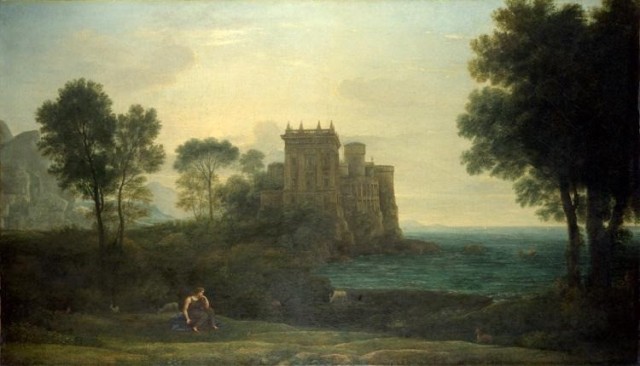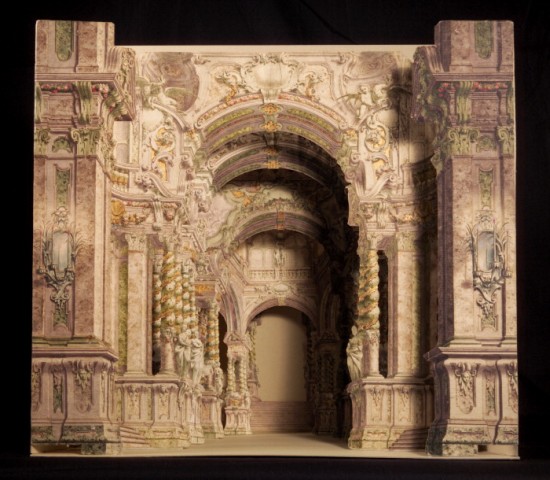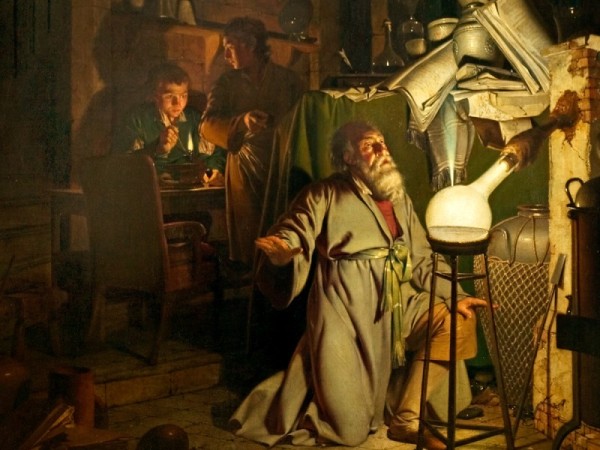 Claude Lorrain, Landscape with Psyche outside the Palace of Cupid, 1664
Claude Lorrain, Landscape with Psyche outside the Palace of Cupid, 1664
National Gallery. Image source: National Gallery
“You know the Enchanted Castle, – it doth stand / Upon a rock, on the border of a Lake, /
Nested in trees….” (Epistle to Reynolds)
(FINAL) PART EIGHT
Claude’s Landscape with Psyche outside the Palace of Cupid, inspired by Apuleius’s story, which Keats sourced for his Ode to Psyche, is a late work of the painter’s, an elegant baroque fantasy with less than the usual “incessant observation of nature” and quality of “Brightness [that] was the excellence of Claude, brightness independent on colour…the evanescent character of light”[1] that Constable valued above all other artistic attributes.
The picture’s shortcomings, its dark, sleeping stillness, as if waiting for someone to step in and breathe life into it, gave literary advantages to Keats. The glimpse of the stone towers and colonnades nested above a foaming sea left him with more “room for Imagination” [2] to improvise a philosophical fairy tale to entertain a sick friend [3] and, later, to develop a recurring motif in his work.
He woke up the painting from its two centuries’ sleep and called it The Enchanted Castle. He rebuilt it repeatedly in his fertile year of 1819. The “marble balustrades”, “polish’d stone”, “diamond paved lustrous long arcades” and “crystalline pavilions” dominate the dreamscape of The Fall of Hyperion, the precious fragment containing his beliefs and doubts about the value of art and poetry distilled from the previous two years of his writing life. He remembers the Elgin Marbles in the motionless postures of the Titans, Saturn and Moneta: “Like sculpture builded up upon the grave / Of their own power. ”
The white heifer from the Epistle to Reynolds is sacrificed another two times, in Ode to a Grecian Urn and The Fall of Hyperion. The narrator’s blissful vision the moment before he is tolled back to his sole self in Ode to a Nightingale by the spell-breaking word “forlorn” is of the Enchanted Castle overlooking the sea.
The fragrant woodland landscape of the Enchanted Castle is where the dreamer, the feeling man, aspires to become a poet who can “‘Labour for mortal good'”. In his attempt to “usurp this height”, [3] Keats’ experiments in poetry were not infallible. He also had to earn a living; and he was getting ill. (Those of us wanting our young poet/prophet to be perfect, prefer to keep Otho, and The Cap and Bells out of our thoughts, only daring to admit them in parenthesis.) During his last year of “posthumous existence” that produced no new poetry, he was still consumed from within by “all that information (primitive sense) necessary for a poem”, and of feeling “the identity of every one in the room” [4] with the same intensity that made a newly created god shriek in pain.
The gap remained, the aching voids between form and expression, imagination and experience, objectivity and subjectivity, universality and the personal. The dialectic irradiates his writing, an intellectual light diffused over the lush landscape. He argues with his own poetry.
 Claude’s Seaport with the Embarkation of Saint Ursula, oil on canvas, 1641. National Gallery, London –
Claude’s Seaport with the Embarkation of Saint Ursula, oil on canvas, 1641. National Gallery, London –
“in no other picture have I seen the evanescent character of light so well expressed.” John Constable, Second Lecture at the Royal Institution, 1836. Image source: Wikipedia.
The “wide arched grace” of Lamia‘s marble palace, an artifice inside an artifice, decorated with “creeping imagery” of trees, reminiscent of Claude’s feathery foliage, is the setting for the battle between rationality and sensual imagination that ends in a world “empty of delight”.
Even more difficult to face than the truth that sexy, brilliant, passionate Lamia is a serpent, is that self-important, negative Apollonius is right. Art must include the real world in its grasp, or it is useless. Denial of reality is self-poison. The inextricable contrarieties of life must be endured if we are to enjoy happiness, rather than spoil each rare joyful moment with regret that it must pass. The dreamer in The Fall of Hyperion is advised to bear: “The pain alone; the joy alone; distinct”.
Keats, the striving writer, was never satisfied that he had found the solution – “ever must I moan, / To question Heaven and Hell and Heart in vain” [5]. Keats was a suffering artist, without affectation; complacency is the death of any artist, “sublime or low”. [6] When we were young, hot for certainties, [7] some of us glided over the question marks in Keats, treating them as if they are the rhetorical flourishes of a Regency ghost – a big mistake, because they are nothing of the sort, they are questions, to be delivered with urgency; they complete the counterpoint; they are part of his chiaroscuro. He described his profession as “straining at particles of light in the midst of a great darkness”. [8]
Towards the end of his lifelong study of nature, Monet’s transcendental, increasingly abstract Nymphéas in the series begun during the early casualties of the First World War, are still real water lilies, “material sublime”, painting them being another word for feeling, a Keatsian twilight fusion with Essence.
 Monet, Water Lilies, Sunset, after 1914.
Monet, Water Lilies, Sunset, after 1914.
Oil on canvas, Musée de l’Orangerie, Paris. Image source: WGA
Given to the French Nation by Monet in 1922
“The pain alone; the joy alone; distinct” (The Fall of Hyperion)
In trying to trace “the shadow of a magnitude” [9], poetry of art, like any other religion, offers us salvation, or, failing that, perspective. Even when we are beyond cure, it brightens our darkness, like a star dying into life, or the subtlest play of scattered light on shade.
The poet-painter controls the field of vision. We all feel better when we have control, when we see a pattern. Viewing an Enchanted Castle in close-up, or led under its imitation marble arches into the wreathed trellises of the interior, we are dazzled into believing it is a private theatre for our fantasies, an exquisite virtual world, architecture for introspection.
 Giuseppi Valeriani: Set of designs for a stage set, 17th Century.
Giuseppi Valeriani: Set of designs for a stage set, 17th Century.
The Samuel Courtauld Trust, The Courtauld Gallery, London
“A rosy sanctuary will I dress / With the wreath’d trellis of a working brain” (Keats, Ode to Psyche)
The poetry of art offers us rescue from a vile world through mediation, not denial, of external realities. The wide shot of ‘Psyche outside the Palace of Cupid’ shows us that the gleaming towers are on the promontory of a wild sea, subject only to the laws of nature and reality, where, without the redemptive powers of imagination and reason, our individual hopes and fears, loves and ambitions “to nothingness do sink.” [10]
The Enchanted Castle is where the poetic soul is made, the place where, in a Turner or Claude painting or Keats poem, self is dissolved by imagination into light. And, yes, penetrating this evanescence is a death-wish, to die upon the midnight with no pain, the kind of fantasy-death without cough, fever, haemorrhage, and sickening belief of having failed, for which Keats yearned and did not have, a sensation as sweet as sex, or drinking wine, knowing the taste of joy will turn to poison in an instant, and drinking again, because truth is beauty.
At this apex of feeling, the poet/painter is tolled back to “self-concentration”,[11] and, by starting the careful selection and combination of forms and colours, “patent yellow or white lead”[12] for sunlight, learned from patient study of art and nature, renews his cycle of creativity.
As for the rest of us, without his “magic casements, opening on the foam / Of perilous seas”, [13] where on earth would we be?
[1] Constable, Lecture II, p307
[2] Keats referring to the Camposanto frescoes in Letters, pp 187-8, a selection edited by Robert Gittings, OUP 1970.
[3] The Fall of Hyperion
[4] Keats, Letters
[5] Letters, 14 February 1819
[6] The Fall of Hyperion
[7] George Meredith, Modern Love, (1862) in one of literature’s truest and most quoted aphorisms “Ah, what a dusty answer gets the soul / When hot for certainties in this our life!—”
[8] Letters
[9] Keats, On Seeing the Elgin Marbles
[10] Keats, When I have fears
[11] Letters
[12] Constable, Lecture II, Memoirs of the Life of John Constable, p307
[13] Ode to a Nightingale
